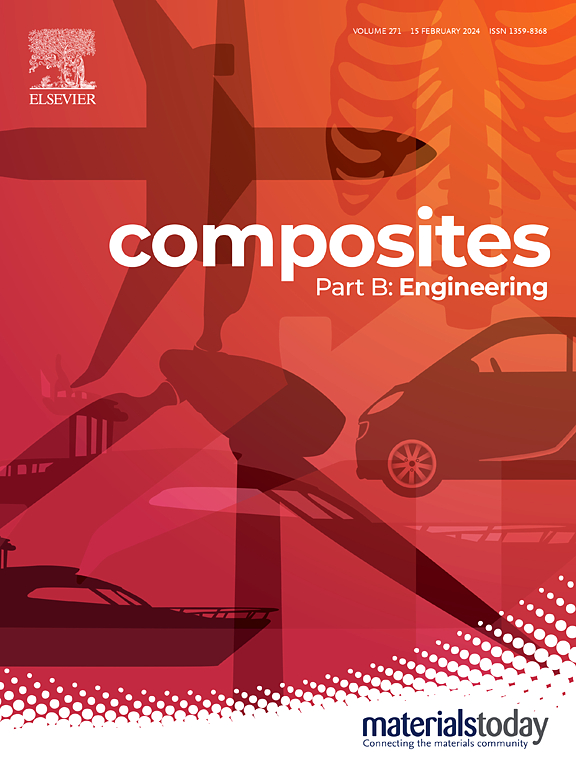Unveiling the anisotropy and mechanism of magnetic alignment of graphene in polymer composites for efficient absorption of THz radiations (0.3–3.0 THz)
IF 12.7
1区 材料科学
Q1 ENGINEERING, MULTIDISCIPLINARY
引用次数: 0
Abstract
Flexible polymer films containing highly aligned graphene flakes were designed using low magnetic field for Terahertz (THz) shielding applications. The alignment of graphene resulted in a unique dark-bright field macroscopic patterns on the cured composite films. On a microscopic scale, the alignment of graphene resulted in a distinctive chain-like structure that favour an effective electron flow path resulting in an electron mobility and optimal electrical conductivity of 7.2 cm2/Vs and 3.3 x 10−7 S/cm, respectively, which is extremely higher than the homogenous composite for the lowest graphene loading of 1 wt%. For the first time, an aligned composite film of 100 μm thickness was characterised using the synchrotron beam in the THz regime – 0.3 to 3.0 THz and exhibited an exceptionally high absorptance of 56.6 % of T-rays for 1 wt% graphene concentration. Simultaneously, the mechanism of orientation and the in-situ alignment of graphene in the magnetic field was characterised using the time-of-flight small angle neutron scattering technique and their probability of alignment, anisotropy factor were estimated. The in-situ neutron experiments indicate that when the applied magnetic field is perpendicular to the wave vector of the incoming neutron beam, a pronounced anisotropy is observed in the total unpolarized beam due to the alignment of graphene flakes. The exploration of magnetic alignment of graphene and determination of optical anisotropy lays foundation for further discovery of aligned graphene-based composite. The outstanding performance and high efficiency of aligned graphene composites present a huge potential in THz devices, polarization control and shielding solutions for T-rays.
揭示石墨烯在聚合物复合材料中磁取向的各向异性和机制,以有效吸收太赫兹辐射(0.3-3.0太赫兹)
采用低磁场设计了包含高度排列的石墨烯薄片的柔性聚合物薄膜,用于太赫兹(THz)屏蔽应用。石墨烯的排列导致固化复合膜上独特的暗-亮场宏观图案。在微观尺度上,石墨烯的排列形成了独特的链状结构,有利于有效的电子流路径,导致电子迁移率和最佳电导率分别为7.2 cm2/Vs和3.3 x 10−7 S/cm,这远远高于最低石墨烯负载为1 wt%的均质复合材料。在太赫兹(0.3 ~ 3.0太赫兹)波段,利用同步加速器束首次对厚度为100 μm的定向复合薄膜进行了表征,在1 wt%的石墨烯浓度下,该薄膜的t射线吸收率高达56.6%。同时,利用飞行时间小角中子散射技术表征了石墨烯在磁场中的取向和原位取向机理,并估计了它们的取向概率和各向异性因子。原位中子实验表明,当外加磁场垂直于入射中子束的波矢时,由于石墨烯薄片的排列,在总非极化光束中观察到明显的各向异性。石墨烯磁性取向的探索和光学各向异性的测定为进一步发现取向石墨烯基复合材料奠定了基础。排列石墨烯复合材料的优异性能和高效率在太赫兹器件、偏振控制和t射线屏蔽解决方案方面具有巨大的潜力。
本文章由计算机程序翻译,如有差异,请以英文原文为准。
求助全文
约1分钟内获得全文
求助全文
来源期刊

Composites Part B: Engineering
工程技术-材料科学:复合
CiteScore
24.40
自引率
11.50%
发文量
784
审稿时长
21 days
期刊介绍:
Composites Part B: Engineering is a journal that publishes impactful research of high quality on composite materials. This research is supported by fundamental mechanics and materials science and engineering approaches. The targeted research can cover a wide range of length scales, ranging from nano to micro and meso, and even to the full product and structure level. The journal specifically focuses on engineering applications that involve high performance composites. These applications can range from low volume and high cost to high volume and low cost composite development.
The main goal of the journal is to provide a platform for the prompt publication of original and high quality research. The emphasis is on design, development, modeling, validation, and manufacturing of engineering details and concepts. The journal welcomes both basic research papers and proposals for review articles. Authors are encouraged to address challenges across various application areas. These areas include, but are not limited to, aerospace, automotive, and other surface transportation. The journal also covers energy-related applications, with a focus on renewable energy. Other application areas include infrastructure, off-shore and maritime projects, health care technology, and recreational products.
 求助内容:
求助内容: 应助结果提醒方式:
应助结果提醒方式:


